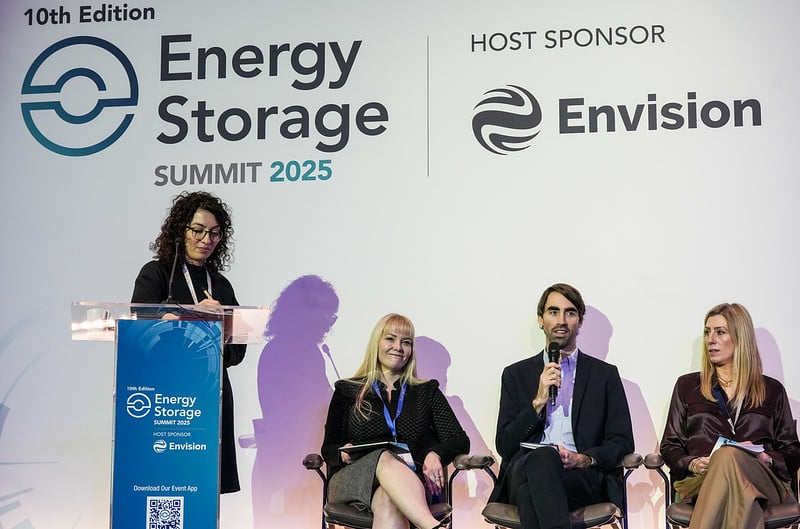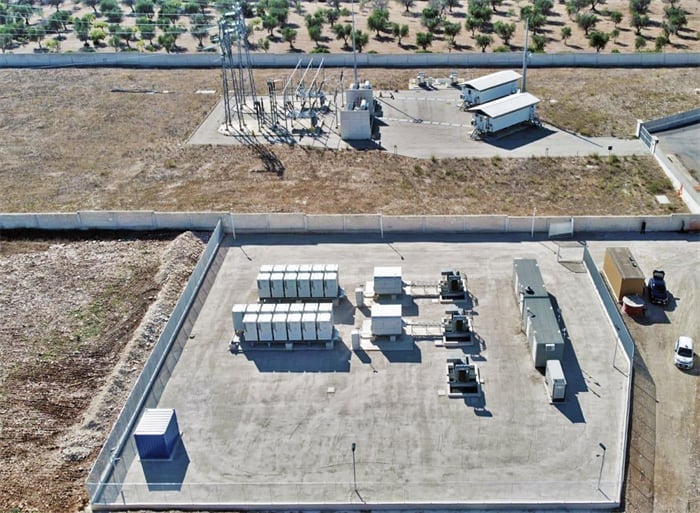
Juan Ceballos, Trina Storage head of sales for Europe, tells ESN Premium how one of solar’s big players aims to become a major presence in energy storage.
The energy storage system integration arm of Chinese vertically integrated solar PV manufacturer Trina Solar officially launched into the overseas market five years ago at the Energy Storage Summit EU 2021.
Enjoy 12 months of exclusive analysis
- Regular insight and analysis of the industry’s biggest developments
- In-depth interviews with the industry’s leading figures
- Annual digital subscription to the PV Tech Power journal
- Discounts on Solar Media’s portfolio of events, in-person and virtual
Or continue reading this article for free
Since then, Trina Storage has taken the occasion of the annual conference—hosted by our publisher, Solar Media—to announce the start of commercial operations of its first project in 2022 and the launch of its second-generation battery energy storage system (BESS) solution Elementa 2 last year, at the 2024 event.
From that initial 50MW/50MWh, 1-hour duration project in Cambridge, UK, Trina Storage now has 2GWh of large-scale battery projects already in operation, under construction or in commissioning at the time of our interview with Juan Ceballos.
Speaking with ESN Premium at the 2025 Energy Storage Summit EU in London last month, Ceballos says around 70-80% of Trina Storage’s customer projects are in the UK, Europe’s leading market by cumulative installations, currently pushing close to the 9GWh mark.
Ceballos was a speaker on a panel discussion at the event: watch a snippet below, where he gives an overview of different European markets.
Expansion to other markets in Europe is underway. Four projects have been deployed in Germany so far. According to the Trina Storage head of sales for Europe, roughly 300MWh more will be brought online within the next two quarters.
Elsewhere, the company has one project each in Italy and Spain, and Ceballos identifies Greece, Poland, the Benelux countries and Portugal as attractive markets: all of the European markets, he says, “where we will see the volumes, that are big enough to focus our attention on and grow in the next few years, and where there are drivers to do so, whether capacity markets, subsidies, whatever it is.”
Adapting to local market requirements
In a panel discussion that Ceballos participated in at the conference, debating which are the hottest markets for storage today in Europe, Britain and Germany stood out as the most commonly cited, while Italy and Poland also got the most frequent mentions as emerging areas of interest.
A recent report from Aurora Energy Research appeared to corroborate this, highlighting Italy, the UK and Germany as the three most attractive markets for BESS investors in the continent.
But what does it take to establish a presence in these markets and adapt to the dynamics of each?
Ceballos says the first obvious point is that for a system integrator like Trina Storage, customers must have trust in their technologies and track record. Trina integrates inverters and controls into its Elementa 1 and Elementa 2 BESS enclosures.

The Trina Storage DC cabinets themselves are Europe-certified, meaning there isn’t much adaptation needed from one market to the next. However, grid compliance for inverters can be trickier, with each country or grid area having its own codes and interconnection requirements. Ceballos says making sure power conversion systems (PCS) are certified for grid codes is perhaps the single biggest technical challenge from market to market.
Customers might also ask for differences in products. For example, in the UK, customers asked Trina to adhere to guidance to include dry pipe sprinkler systems (pipes which are not constantly filled with water) inside the cabinet. In Greece, deflagration panels are required within the DC cabinet.
“Then, more than the technology itself, each country will have different customer expectations, maybe in terms of how they will monetise the asset, how flexible the capacity warranty needs to be, and what certificates they need,” Ceballos says.
Safety: A ‘valid concern’ that the industry needs to provide reassurance around
Anyone who, like this author, combs mainstream media sources for news about energy storage projects will see that perceptions of fire safety greatly impact energy storage’s ability to get buy-in from local communities.
The fire at Moss Landing Energy Storage Facility in California is the most high-profile recent example, but there have been others. While statistically, fires are rare and decreasing in frequency even as the industry grows rapidly, Ceballos says it’s understandable that the public and even local authorities focus on the negative headlines.
“When we talk about safety, it’s a valid concern. The public doesn’t know how the battery works. They have seen the news, and it’s something you need to reassure them on,” he says.
That process of reassurance begins with helping local planners, local authorities, councils, and other stakeholders, including fire services, understand what the risks are. Ceballos notes, too, that many of the reported fires have involved systems that may only be a few years old but nonetheless went into operation before many of today’s best practices, standards, and technology advances happened.
Ceballos claims that for Trina Storage, “there is no negotiation around safety.”
“[The solution] must be compliant with the highest standards in terms of safety. Otherwise, you have no place in the market,” he says.
“The new products we are building are in accordance with all the IEC, UL certifications and so on. We’ve now included not only NFPA 69 but NFPA 68 compliance, so we have both active ventilation and deflagration panels.”
“On top of all of that, we’ve done large-scale fire tests (LSFTs) to prove that actually, the system works if there is a real fire incident (Editor’s note: Trina announced the completion of ‘rigorous burn testing’ of Elementa 2 in October last year). This is one of the key aspects: you need to have the certification, but also the knowledge and the reassurance towards the customers. Give them enough material so they can also explain to the local councils or the local population that the risk is under control.”
ESG: Trina looks to get ahead of EU Battery Passport requirements
ESG is another area that Ceballos says is non-negotiable and where customers in Europe have high expectations.
The European Union (EU) is looking to be a world leader in battery sustainability, in 2023 voting to adopt a new battery regulation directive that replaced its previous incarnation, in place since 2006.
ESN Premium asks how Trina Storage is preparing for the implementation of that legislation, particularly the forthcoming Battery Passport which aims to make sustainability credentials and supply chain traceability transparent.
Ceballos says Trina Storage has been working with certifications and standards group TUV on Battery Passport compliance and sees itself being ahead of the curve before the requirements come into effect.
“The Battery Passport, for now, is more about CE marking and QR codes [that give evidence of supply chain accountability], but in the future, it will imply using recycled materials, recycling your own batteries, and traceability aspects,” Ceballos says.
“Trina wants to be on top of things, so we have a roadmap that is hitting those milestones earlier than the battery passport requires. We are already implementing traceability within the battery cells using the QR code of the cells, the same way we do for PV modules.”
That full implementation hasn’t been completed yet but “will be very soon,” he says and adds that beyond the mandatory requirements, sustainability is also a selling point.
‘Strong Chinese DNA’ as a competitive differentiator
One of Trina’s advantages in supply chain traceability is perhaps one of its major advantages that has seen the parent company rise in the solar PV sector: vertical integration.
The company manufactures lithium iron phosphate (LFP) battery cells in-house, invests in R&D and can expand manufacturing capacity in response to market demand, Ceballos says.
Behind all of this lies what the sales head describes as “strong Chinese DNA in the background, which brings competitive, innovative manufacturing from China,” as evidenced by its 30-year history in solar PV.
Ceballos claims this combination of vertical integration to control the supply chain coupled with ‘Chinese DNA’ makes Trina Storage extremely competitive.
When paired with the local presence the system integrator has established within its European target markets, he argues that it puts the company in a strong position for opportunities such as the much-anticipated MACSE tenders, a sort of capacity market auction mechanism run by the Italian transmission system operator (TSO) Terna that will award 17-year contracts with strict battery degradation and duration requirements.
This article has been amended from its original form to reflect the definition of a dry pipe sprinkler system as featured in Trina Storage’s UK version of Elementa 2 and to add a reference to the company’s large-scale fire testing announcement.

